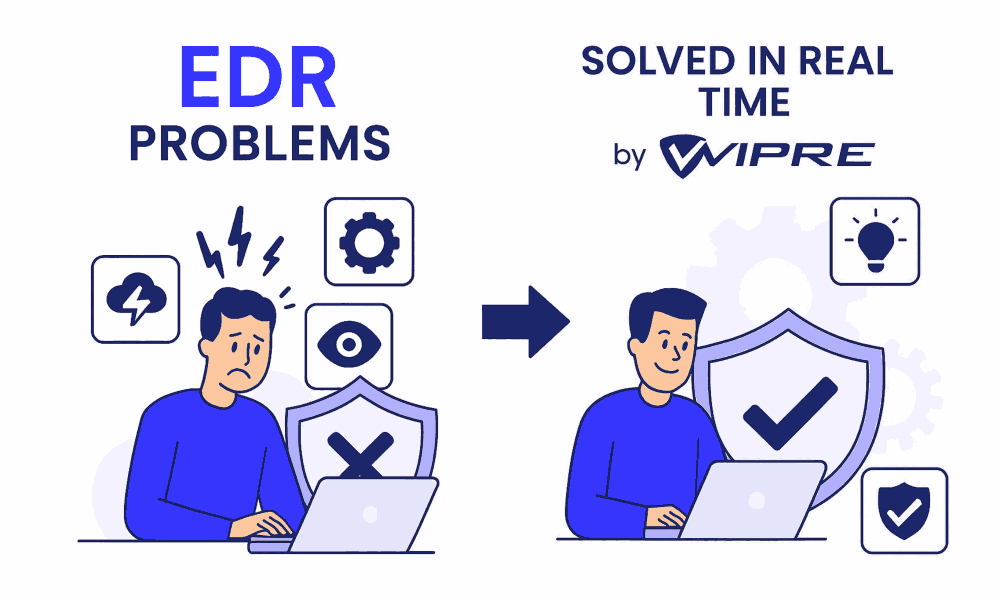Endpoint Detection and Response
Endpoint Detection and Response (EDR) like VIPRE, continuously monitors your PC and Laptop for threats, detects suspicious activity, and automates responses to contain and remediate Cyberattacks using Real-time analytics, AI, and machine learning.


🛡️ What Is Endpoint Detection and Response (EDR)?
Endpoint Detection and Response (EDR) is a specialized Cybersecurity technology like VIPRE_EDR_Solutions are designed to protect endpoint devices such as laptops, desktops, servers, mobile phones, and IoT devices; within an organization's network. Unlike traditional antivirus software that relies on known malware signatures, EDR uses real-time behavioral analysis, artificial intelligence (AI), and machine learning (ML) to detect and respond to sophisticated threats like ransomware, fileless malware, and zero-day exploits, thus providing robust endpoint security.
🔍 Core Functions of EDR
EDR platforms typically offer the following core endpoint security capabilities:
Continuous Monitoring: EDR tools monitor endpoint activities 24/7, capturing data such as process execution, file access, registry changes, and network connections.
Threat Detection: Using behavioral analytics and threat intelligence, EDR identifies suspicious patterns that may indicate malicious activity.
Automated Response: Once a threat is detected, EDR can automatically isolate the affected endpoint, terminate malicious processes, and initiate remediation workflows.
Investigation and Forensics: Security teams can use Endpoint Detection and Response or EDR, to conduct deep investigations, trace attack paths, and understand the root cause of incidents.
Threat Hunting: EDR enables proactive threat hunting by allowing analysts to query endpoint data and uncover hidden threats before they cause damage.
🧠 How Endpoint Detection and Response (EDR) Works
EDR solutions like VIPRE_EDR_Solutions deploy lightweight agents on Endpoint devices. These agents collect telemetry data and send it to a centralized platform for analysis. The Endpoint Detection and Response platform uses Artificial Intelligence / Machine Learning algorithms to detect anomalies and correlate events across endpoints. When a threat is identified, Endpoint Detection and Response can take automated actions or alert security analysts for manual intervention. For example, if an endpoint starts communicating with a known command-and-control server, the EDR system may flag this behavior, isolate the device from the network, and log the event for further investigation.
🏢 Why EDR Is Critical for Organizations
In today’s threat landscape, Cyberattacks are becoming more frequent, sophisticated, and damaging. Traditional security tools often fail to detect advanced threats that evade signature-based detection. Endpoint Detection and Response or EDR fills this gap by providing Endpoint Security as below:
Real-time visibility into endpoint activities
Rapid detection and containment of threats
Improved incident response and recovery
Compliance support for regulations like GDPR, HIPAA, and PCI-DSS
EDR is especially valuable for organizations with remote workforces, cloud-based infrastructure, and BYOD (Bring Your Own Device) policies, where endpoints are often the weakest link.
🧩 Integration with Other Security Tools
EDR is often part of a broader endpoint security ecosystem that includes:
SIEM (Security Information and Event Management): EDR feeds endpoint data into SIEM platforms for centralized analysis.
XDR (Extended Detection and Response): EDR integrates with network, cloud, and identity data to provide unified threat detection.
SOAR (Security Orchestration, Automation, and Response): EDR actions can be orchestrated through SOAR platforms for automated incident response.
🚨 Common Threats EDR Can Detect
The Endpoint Detection and Response can detect the following and provide strong endpoint security:
Ransomware: Encrypts files and demands payment; EDR can detect encryption behavior and isolate infected devices.
Fileless Malware: Operates in memory without leaving traces on disk; EDR monitors memory and process behavior.
Credential Theft: Attackers steal login credentials; EDR can detect unusual login patterns and privilege escalation.
Lateral Movement: Attackers move across the network; EDR tracks connections and access attempts.
🧪 Use Cases of EDR and Benefits
A few use cases of Endpoint Detection and Response and its benefits are enumerated below:
Enterprise Security: Large organizations use EDR to protect thousands of endpoints and provide endpoint security across multiple locations.
Managed Detection and Response (MDR): EDR data powers MDR services that offer outsourced threat monitoring.
Incident Response: Endpoint Detection and Response accelerates response times and reduces dwell time—the period attackers remain undetected.
Threat Intelligence: EDR platforms often integrate with threat intelligence feeds to enrich detection capabilities.
🛠️ EDR: The Challenges and Considerations
While Endpoint Detection and Response offers powerful endpoint security and protection, it comes with challenges:
Complexity: Requires skilled analysts to interpret data and manage alerts.
False Positives: Behavioral detection can sometimes flag benign activity.
Resource Usage: Endpoint Security agents may consume CPU and memory.
Integration: The EDR being used must be compatible with existing IT infrastructure.
Organizations should evaluate EDR solutions based on scalability, ease of use, detection accuracy, and integration capabilities.
🌟 VIPRE: The Best EDR Software
VIPRE EDR Solutions enhance Endpoint Detection and Response capabilities by offering a lightweight, easy-to-deploy solution that combines advanced threat detection with intuitive management. This EDR uses machine learning and real-time behavior analysis to identify threats across endpoints and respond swiftly, thus providing excellent endpoint security. VIPRE has a centralized dashboard that allows IT teams to monitor devices, automate responses, and conduct forensic investigations with minimal overhead. Its low resource footprint and seamless integration with existing systems make it ideal for Businesses seeking robust endpoint security and protection, without complexity.
Watch Video below:

Cyber Security Threats
Malwarebytes Premium
Protect all your devices from all Malware and Viruses
© 2025. All rights reserved.
